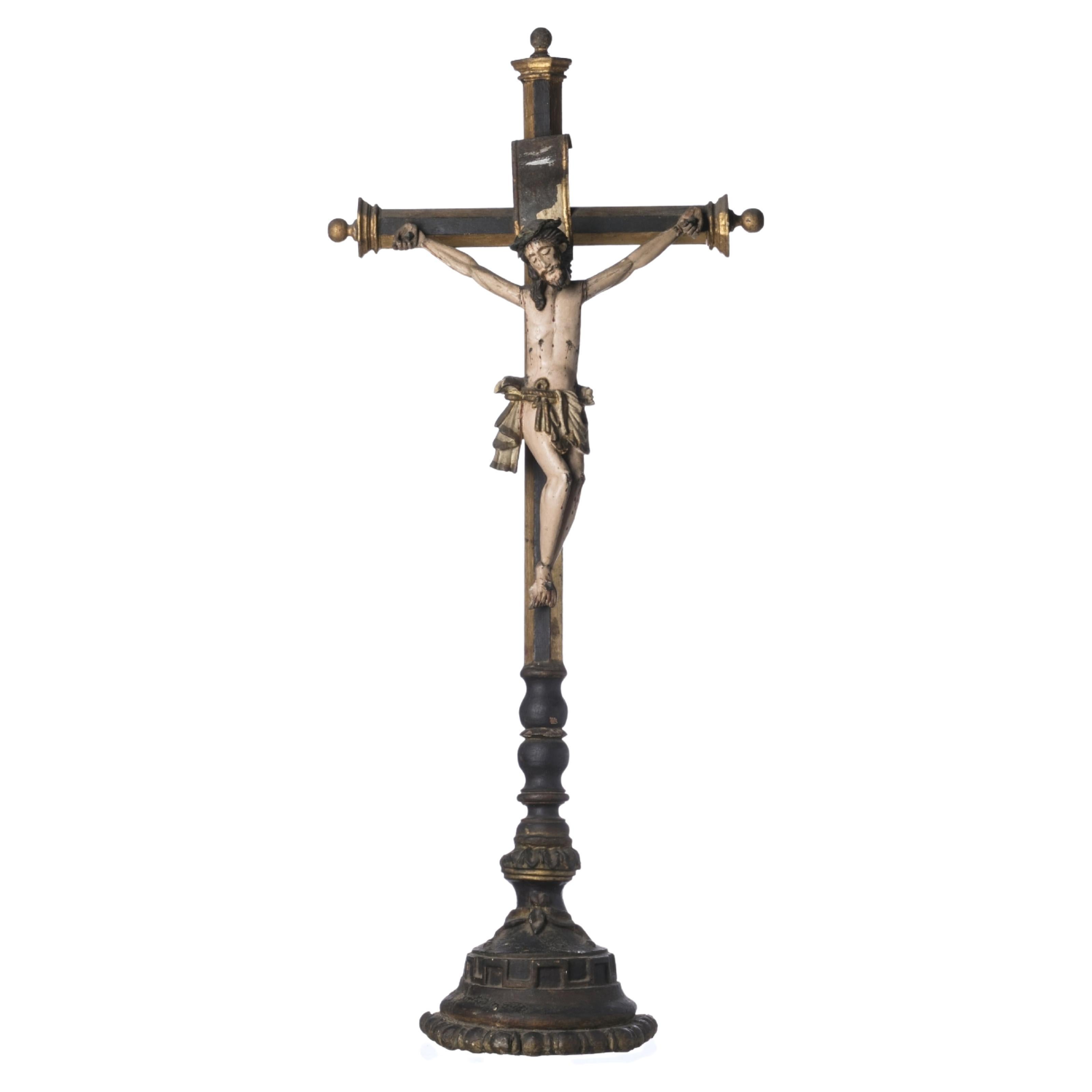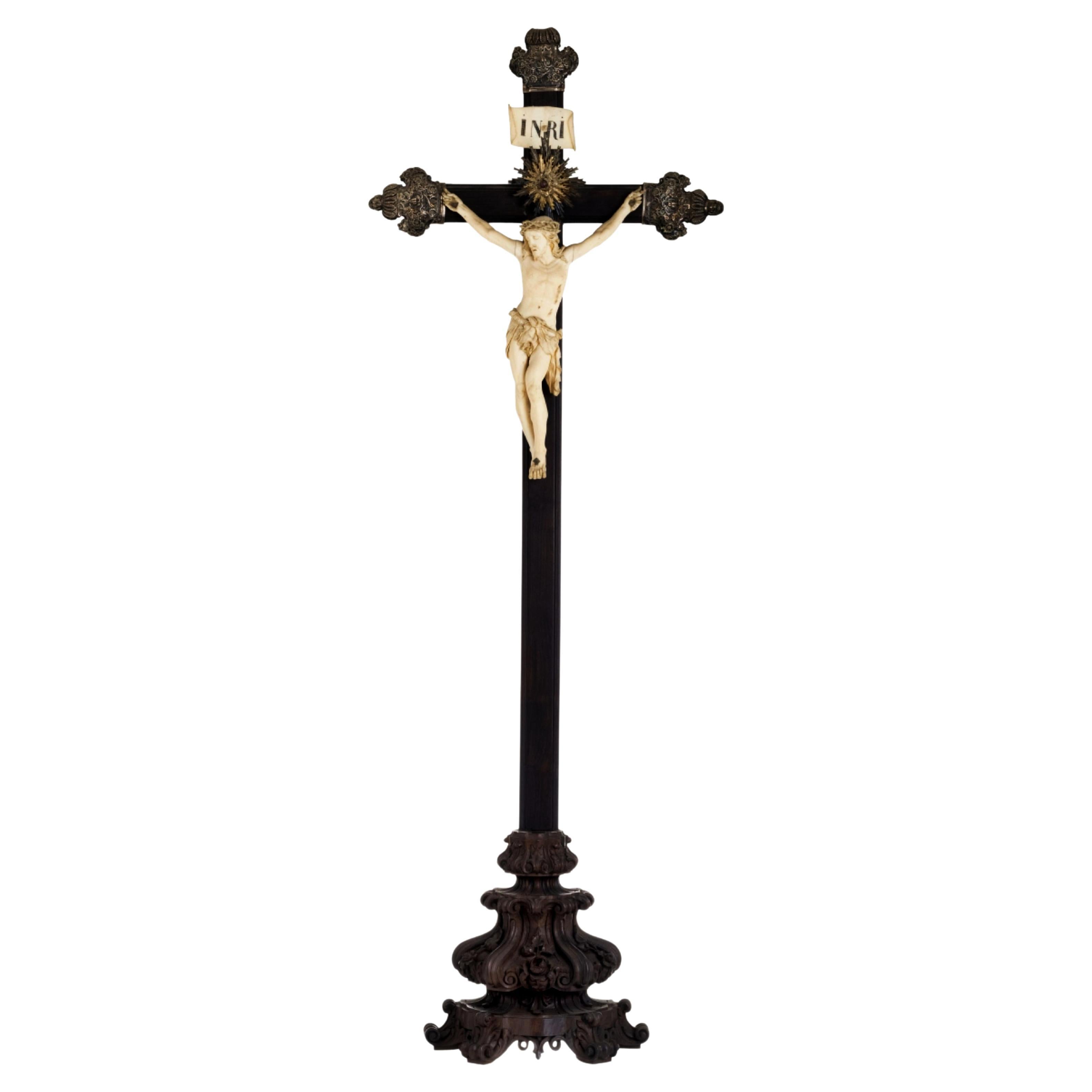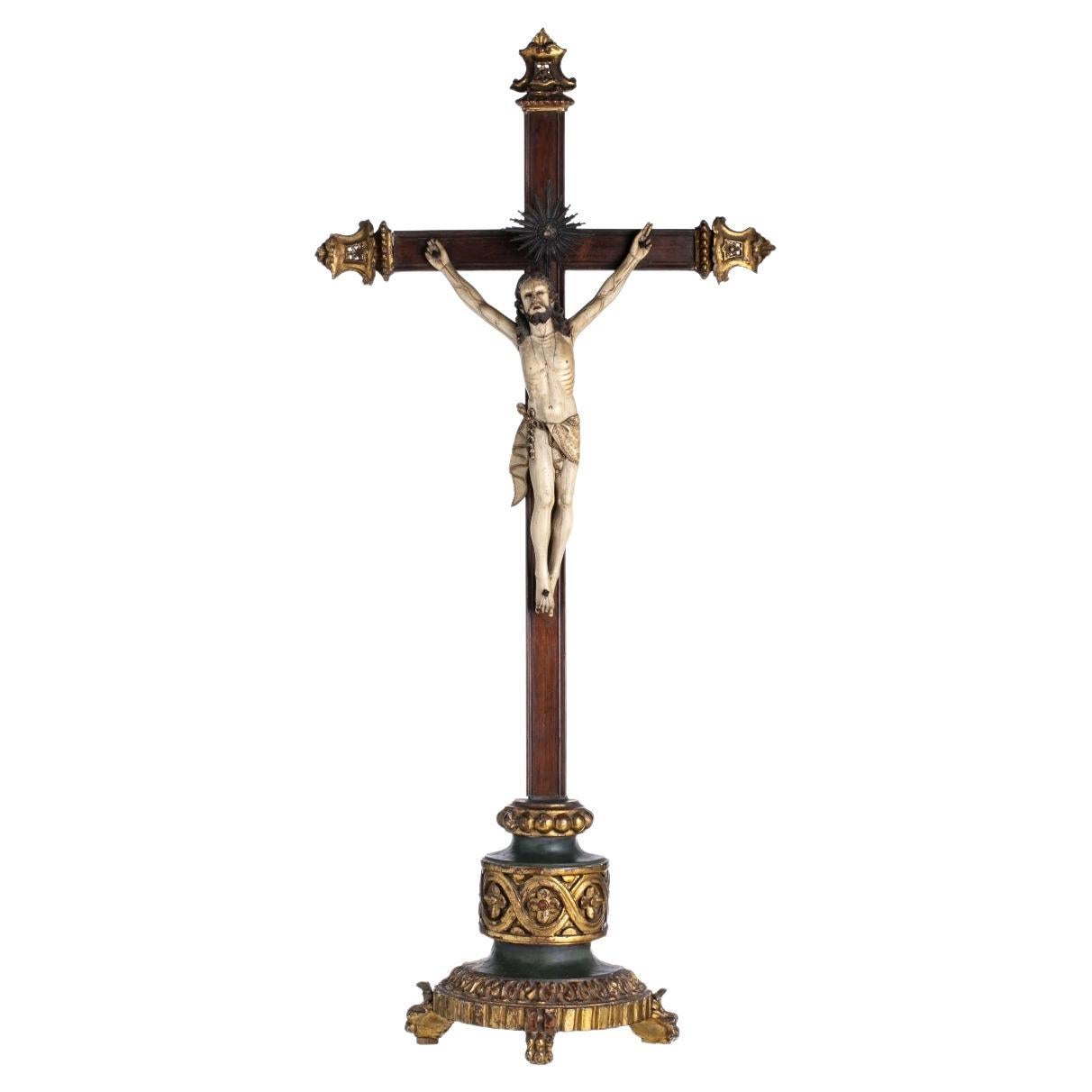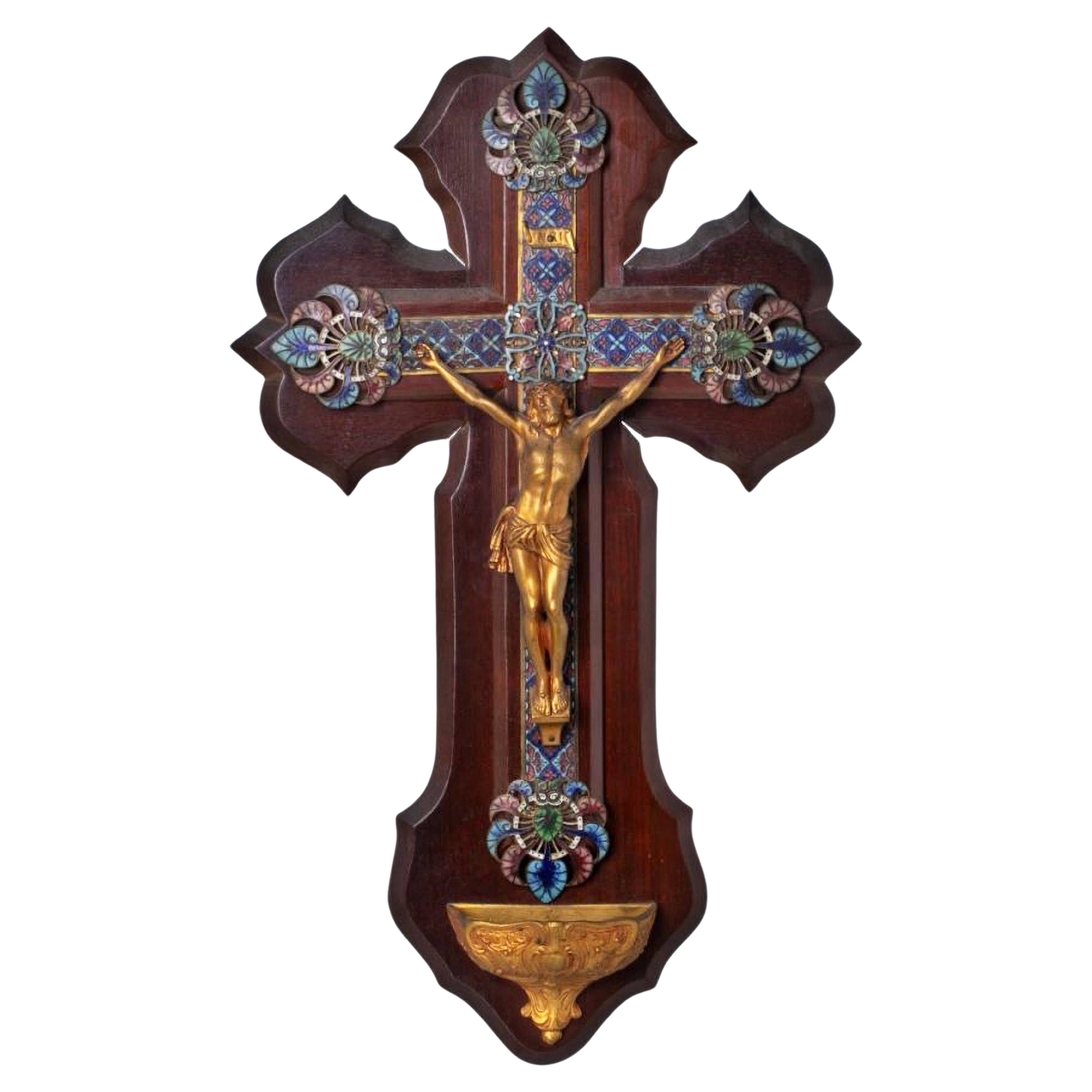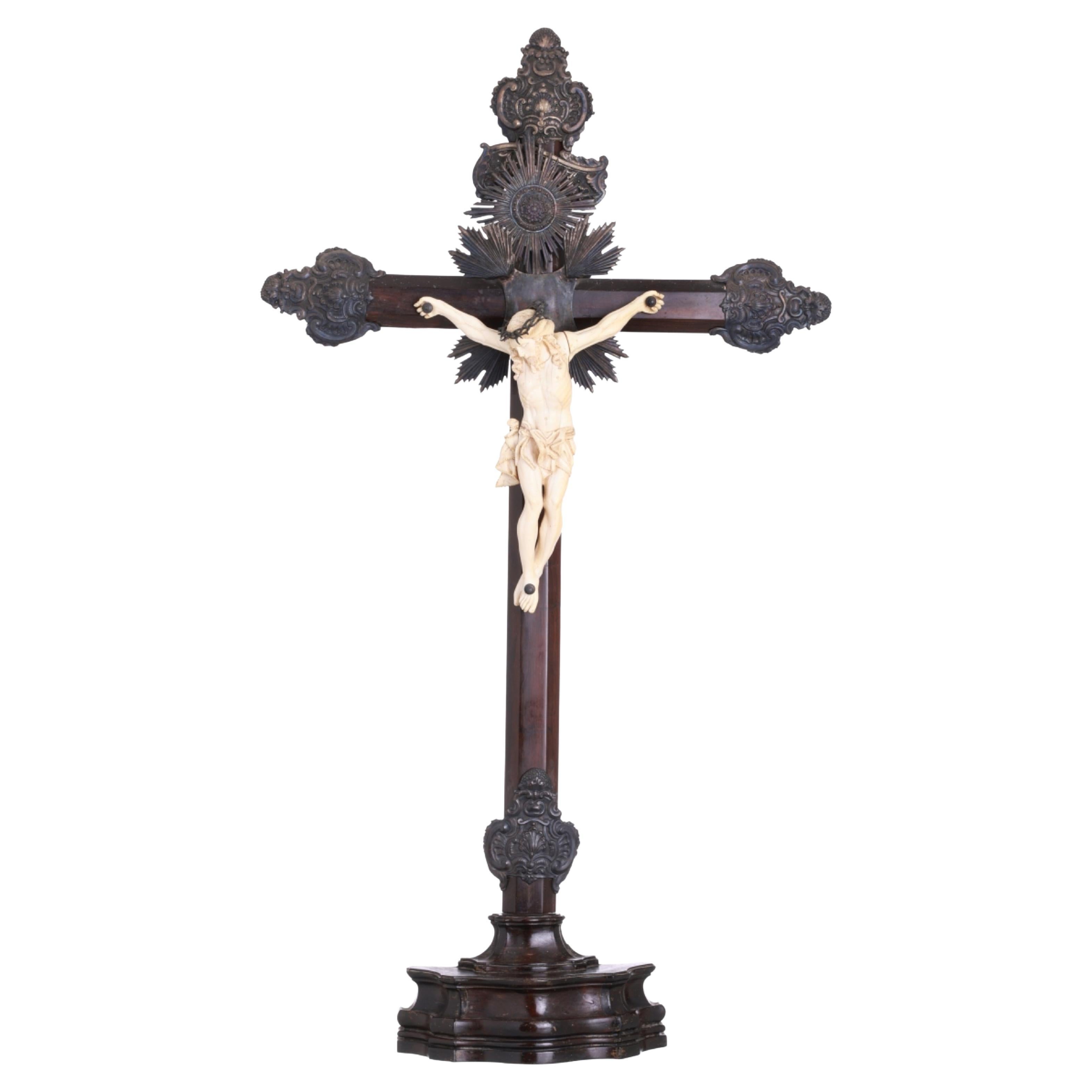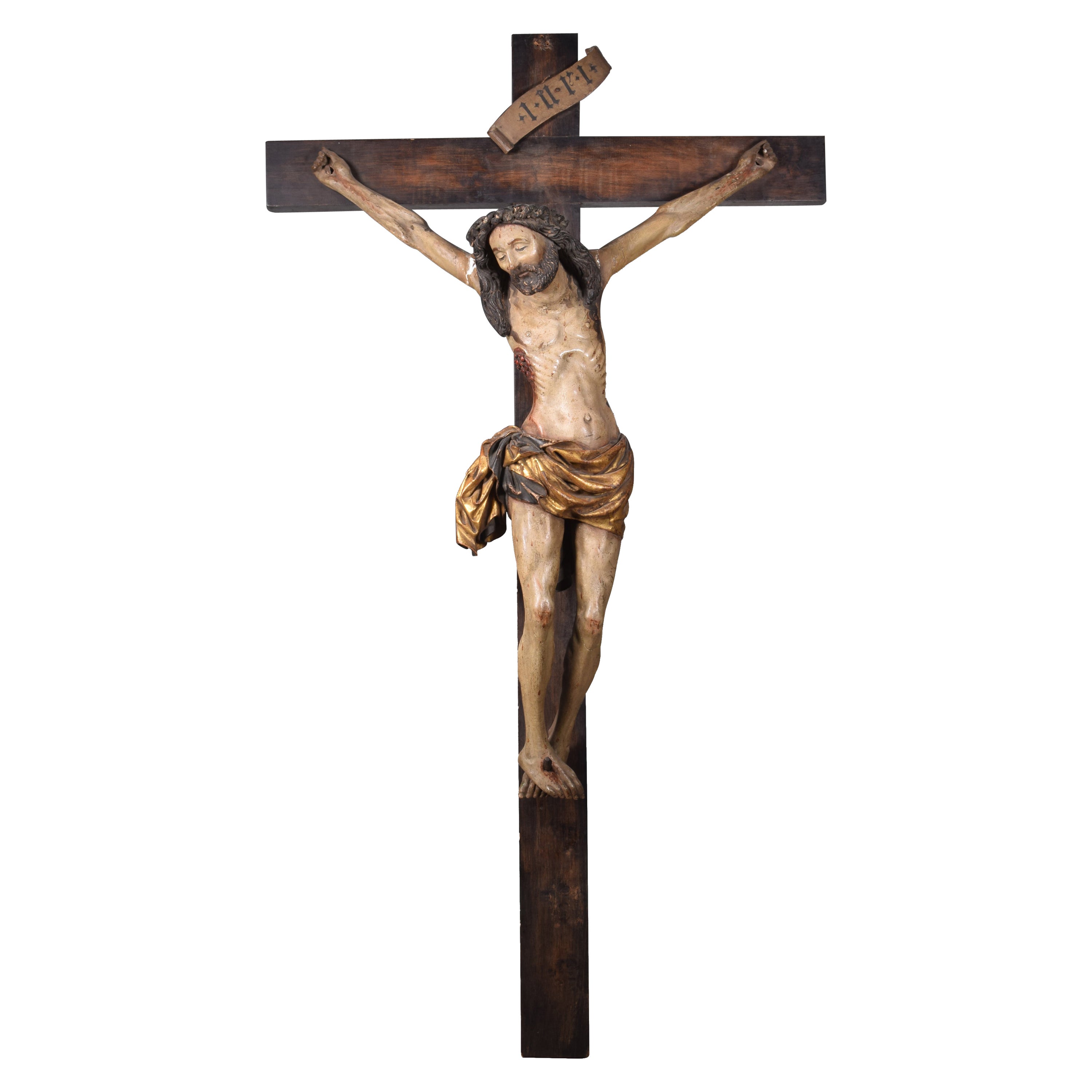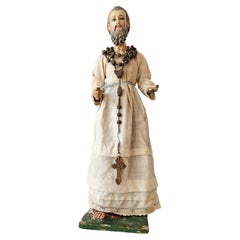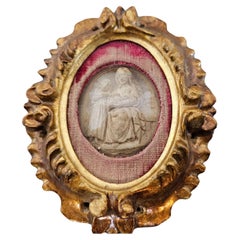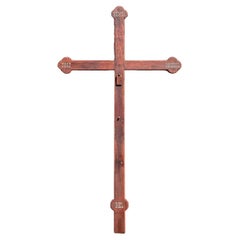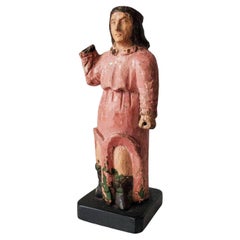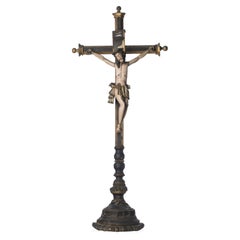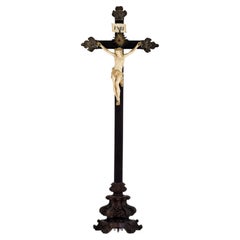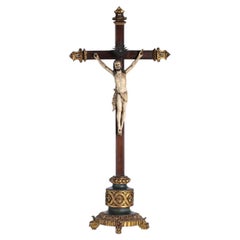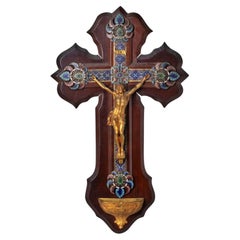Items Similar to 18th Century Spanish Baroque Period Christ Crucified Altar Sculpture
Want more images or videos?
Request additional images or videos from the seller
1 of 11
18th Century Spanish Baroque Period Christ Crucified Altar Sculpture
$5,500
£4,173.27
€4,771.77
CA$7,682.01
A$8,541.35
CHF 4,459.82
MX$103,969.01
NOK 56,905.37
SEK 53,317.61
DKK 35,612.56
Shipping
Retrieving quote...The 1stDibs Promise:
Authenticity Guarantee,
Money-Back Guarantee,
24-Hour Cancellation
About the Item
A scarce Baroque Period Spanish altarpiece retablo / reredo, by (attributed) Luis Salvador Carmona (1708-1767), depicting thorn crowned Christ crucified / Cristo crucificado hand carved, polychromed wood with forged iron nails, mounted on later plaque.
This rare antique religious work / object of art, circa 1750, most likely commissioned by the Catholic Church of Spain, destined to be prominently displayed as an altarpiece / retablo or as part of a much larger reredo, directly behind the main altar at a Spanish or Continental European Catholic Church (French, Italian, Iberian, Portuguese)
The Crucified Christ, displayed mounted on a later faded red fabric upholstered shaped backboard plaque with textured gilt border. The exceptional hand sculpted, carved, gessoed, polychrome painted figure depicting bloodied Jesus, with crown of thorns atop his head, only wearing a undulating shaped cloth around his loin, arms extended and feet crossed, spear head form iron nails through both. The verso covered in an old paper printed backing with metal hook hardware at top for wall hanging.
Dimensions (approx):
Overall:
22" High, 14.5" Wide, 3.25" Deep
Figure only:
16" High, 10" Wide, 3" Deep
Historical background:
Artist: (attrib)
Luis Salvador Carmona (1708, Nava del Rey – 1767, Madrid) was a Spanish Baroque sculptor who came from a family of artists, including uncle of Manuel Salvador Carmona. He was sent to be trained in Madrid in the workshop of Juan Alonso Villabrille y Ron (1663-after 1728), under whom he worked from about 1723. On Villabrille y Ron's death after 1728, Salvador Carmona continued working under the former's son-in-law José Galbán (1705-1766) until about 1732 when he set up his own highly efficient workshop in Madrid, which he ran for over 30 years. He mostly produced religious works.
Carmona was one of the most important Spanish Court sculptors. He was heavily involved in the decoration of the Royal Palace of La Granja, and was a founding member of the Academia de Bellas Artes. His official role at Court, combined with his extraordinary technical ability, inspired many of his colleagues and patrons, stimulating demand for his work in all of Spain.
This 18th century ecclesiastical work displays various decorative elements of 17th century Sevillian school style of Juan de Mesa (c.1583–1627), whose important realistic works are still used centuries later in the procession during the Holy Week in Seville. His works influenced many later religious artists, including Luis Salvador Carmona.
"Cristo de la buena Muerte" translated "The Christ of the Good Death" or "Christ of Mena" are the invocations of Christ that arise from an original monumental sized carving of the Crucified Christ by Pedro de Mena (1628-1688; Granada) dated approximately 1660, and which was preserved in the Church of Santo Domingo until its destruction.
--
We absolutely love antique religious items! Especially architectural elements, old church artwork, and rare, one-of-a-kind works. If you're interested in other examples, including important Buddhists, Christian, Hindu, Islamic, and other religion items, architectural salvaged, ornamental church / temple / mosque building elements, reliquary, tabernacle, altar, altarpiece, credence table, kneelers, European old world relics, Spanish Colonial retablo paintings, Santo figures or Mexican / Central American religious folk art, home shrine, Gothic vestment cabinet, vestry, baptismal fonts, and more, please be sure to check our other listings.
- Similar to:Juan De Mesa (Sculptor)
- Dimensions:Height: 22 in (55.88 cm)Width: 14.5 in (36.83 cm)Depth: 3.25 in (8.26 cm)
- Style:Baroque (Of the Period)
- Materials and Techniques:
- Place of Origin:
- Period:
- Date of Manufacture:circa 1750
- Condition:Wear consistent with age and use. Minor losses. Minor fading.
- Seller Location:Forney, TX
- Reference Number:1stDibs: LU5977227054072
About the Seller
4.8
Platinum Seller
Premium sellers with a 4.7+ rating and 24-hour response times
Established in 2013
1stDibs seller since 2021
294 sales on 1stDibs
Typical response time: <1 hour
- ShippingRetrieving quote...Shipping from: Forney, TX
- Return Policy
Authenticity Guarantee
In the unlikely event there’s an issue with an item’s authenticity, contact us within 1 year for a full refund. DetailsMoney-Back Guarantee
If your item is not as described, is damaged in transit, or does not arrive, contact us within 7 days for a full refund. Details24-Hour Cancellation
You have a 24-hour grace period in which to reconsider your purchase, with no questions asked.Vetted Professional Sellers
Our world-class sellers must adhere to strict standards for service and quality, maintaining the integrity of our listings.Price-Match Guarantee
If you find that a seller listed the same item for a lower price elsewhere, we’ll match it.Trusted Global Delivery
Our best-in-class carrier network provides specialized shipping options worldwide, including custom delivery.More From This Seller
View All17th/18th Century Baroque Period Carved Polychrome Santo Altar Statue
Located in Forney, TX
A scarce Baroque period Spanish or Italian hand carved polychrome painted wood Santo sculpture with inset colored glass eyes, original white robe garb and later wood rosary.
Intrica...
Category
Antique Early 18th Century European Baroque Religious Items
Materials
Gesso, Wood, Paint
Antique Italian Religious Giltwood Reliquary Relief Carved Sculpture
Located in Forney, TX
A rare antique Italian giltwood framed reliquary. 18th/19th century, hand carved giltwood frame housing an exceptional relief carving, d...
Category
Antique Early 19th Century Italian Baroque Religious Items
Materials
Bone, Giltwood
Monumental 19th Century Dutch Church Painted Wood Cross
Located in Forney, TX
A massive nearly 10 foot tall by 5.5 foot wide antique Dutch ecclesiastical wooden cross.
Hand-crafted in the Netherlands in the 19th century, very large sculptural Celtic cross for...
Category
Antique 19th Century Dutch Folk Art Religious Items
Materials
Iron
19th Century Spanish Colonial Religious Folk Art Santo Altar Figure
Located in Forney, TX
An antique Spanish Colonial period hand carved and painted santo church altar figure. Born in Mexico in the first half of the 19th century, the religious...
Category
Antique 19th Century Mexican Folk Art Religious Items
Materials
Wood, Paint
Antique Spanish Colonial Santo Religious Altar Figure
Located in Forney, TX
An exceptional example of Spanish Colonial style, born in Mexico in the 19th century, this large hand carved and painted santo religious folk art altar f...
Category
Antique 19th Century Mexican Spanish Colonial Religious Items
Materials
Glass, Art Glass, Wood, Paint
17th Century Spanish Colonial Hispano-Philippine Carved Santo
Located in Forney, TX
A scarce 17th century Spanish Colonial carved wood santo with provenance from the National Museum of the Philippines Manila.
circa late 1600s
A large part of what makes this example so very rare is not just the age and condition, but the saint depicted, San Roque.
The Hispano-Philippine (Spanish-Filipinos) hand carved hard wood religious altar figure presents splendidly, with scattered remnants of original gesso and polychrome pigments, the exceptionally sculpted religious folk art depicting San Roque (Saint Roch or Rocco), the 14th century Catholic patron saint frequently invoked against the plaque, various infectious disease, as well as patron saint of dogs, invalids, of falsely accused people, and of bachelors, amongst others.
Provenance / Acquisition:
Retaining registration - identification label to verso from The Republic of the Philippines (RP) National Museum of the Philippines Manila with hand written registration number.
Acquired from highly reputable auction house, Austin Auction Gallery, est. 1982, Austin, Texas. February 2022 catalog.
Dimensions: (approx)
Overall: 15.75" High, 5" Wide, 4" Deep.
Figure: 14" High
1.5lbs
Great original antique condition, especially considering it's around 350 years old. Nicely aged patina over the whole. Presented on a later wood plinth base. Typical loss to right arm, minor finish losses, old tiny metal plate added to prevent age related splitting, all wear consistent with age, and only adds to the overall sophisticated character, authenticity, and charming rustic warmth that can only be acquired over long periods of time.
We here at Lynx Hollow Antiques absolutely love religious antiques, from an antique altar, church architectural salvaged building and ornamental elements, reliquary, tabernacle cabinet...
Category
Antique 17th Century Spanish Colonial Religious Items
Materials
Gesso, Hardwood
You May Also Like
JESUS CHRIST CRUCIFIED Portuguese Sculpture from the 17th Century
Located in Madrid, ES
JESUS CHRIST CRUCIFIED
17th Century Portuguese sculpture
in carved wood, polychrome and gilded.
Small flaws in the polychromy.
Height: (Christ) 32 cm. Height: (total) 86 cm.
good co...
Category
Antique 17th Century Portuguese Baroque Religious Items
Materials
Wood
JESUS CHRIST CRUCIFIED 18th Century Italian Sculpture
Located in Madrid, ES
JESUS CHRIST CRUCIFIED 18th Century
Italian Sculpture
in ivor.... The figure is represented dead, wearing a cendal point at the waist. Cross in carved rosewood wood. Silver termin...
Category
Antique Early 18th Century Italian Baroque Religious Items
Materials
Wood
JESUS CHRIST CRUCIFIED Indo-Portuguese sculpture from the 18th Century
Located in Madrid, ES
JESUS CHRIST CRUCIFIED
Indo-Portuguese sculpture from the 18th Century
in ivor..... The figure is represented in agony, with cendal draped around the waist. Cross in rosewood wood ...
Category
Antique Early 18th Century Portuguese Baroque Religious Items
Materials
Wood
JESUS CHRIST CRUCIFIED European, 19th century
Located in Madrid, ES
JESUS CHRIST CRUCIFIED
European, Germany ? 19th century
Christ and font in bronze, wooden cross, covered with enamel.
Slight wear.
Dim.: (cross) 50 x 30 cm;
Height: (christ) 16 cm...
Category
Antique 19th Century German Baroque Figurative Sculptures
Materials
Bronze
JESUS CHRIST CRUCIFIED Indo-Portuguese sculpture from the 18th Century
Located in Madrid, ES
JESUS CRISTO CRUCIFICADO
Indo-Portuguese sculpture from the 18th century
in ivor... Cross in carved rosewood and base in gilded wood. The figure is repres...
Category
Antique Early 18th Century Portuguese Baroque Religious Items
Materials
Wood
Crucified Christ, Sorrowful Crucifix. Carved and polychrome wood.
Located in Madrid, ES
Crucified Christ, Sorrowful Crucifix. Carved and polychrome wood. Possibly southern German school, 15th century.
Polychrome and gilded wood carving showing Christ with the Crown of Thorns, on the Cross, already deceased (eyes closed), with the usual INRI phylactery on the upper crossbar of the Latin cross, three nails (note the crossed feet) and a short, golden and polychrome purity cloth or perizonium. It is known, in German, as “Gabelkreuz” or “Gabelkruzifix” (“Sorrowful Crucifix” in Spanish) to a type of Gothic Crucified Christ that is especially expressive (prioritizing external suffering over other aspects) and that, normally, presents the cross in a of Y or ypsilon (alluding to the Tree of Life), created, apparently, thanks to the influence of the mysticism of the late 13th and early 14th centuries (Saint Brigid...
Category
Antique 15th Century and Earlier European Renaissance Religious Items
Materials
Other
More Ways To Browse
Spain Cross
Spanish Crosses
Baroque Cross
Spanish Baroque Art
Spain Religious Sculpture
High Altar
Church Altar
Home Altar
Iron Nail
Italian Baroque Fabric
Altar France
18th Century Painted American Furniture
Antique Italian Altar
Antique Carved Wood Religious Sculpture
Paintings 18th Century Religious Paintings
Antique Church Altars
Gilt Altar
Hand Carved Santos
